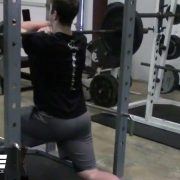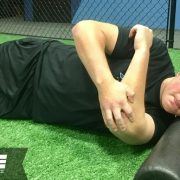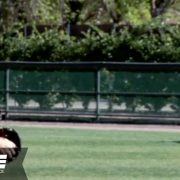Controlling the Running Game: Should Young Pitchers Slide Step?
One of the biggest challenges that a young pitchers faces comes when they have to make that jump from the Little League mound to the big mound at the next level.
The difference between pitching at 46 ft and 60 ft is absolutely huge. And it can wreck havoc on a young pitcher’s arm, mechanics, and effectiveness, not to mention his self confidence.
Thankfully, the trend has been moving towards 50’/70’ or some other modified proportions to help make that adjustment a little more gradual. But even in those cases, that transition still involves some other adjustments like learning to control the running game.
Learning the mechanics of pitching from the stretch is easy enough. A lot of Little League pitchers choose to pitch from the stretch, anyway, to keep things simple, but now they have to deal with the added element of baserunners leading off the base.
At least they don’t have worry about these players on the basepaths…
Nobody likes players stealing off them left and right, so the natural tendency is to speed up your pitching delivery. This isn’t always a bad thing, but, you want to at least give your catcher a chance, right?
If you just go with a big slow leg lift every time, it doesn’t matter how good your catcher is – that stolen base is on you!
But there’s a difference between being “quick to the plate” and “rushing” your delivery.
And one of the things I hear a lot from young pitchers going through this transition is that their coach wants all his pitchers going with a slide step when pitching from the stretch.
Why I Don’t Like the Slide Step in Young Pitchers
Well here’s why I’m not a big fan of the slide step, especially for young pitchers:
Never sacrifice the quality of the pitch in order to be quick to the plate. So let’s think about this… What is your #1 job as a pitcher?
Get the batter out.
Okay, and how do you do that?
Make good pitches. (Keep it simple)
And this is why I don’t like the slide step for young pitchers. Because you’re placing the emphasis (and the pitcher’s attention) on the baserunner, not the batter. And when young pitchers just starting to get used to pitching with runners leading off, this can really take away from their focus and leads to all kinds of problems, like falling behind in the count.
So now, not only are you taking the mental focus off the batter (and sacrificing the quality of the pitch that way) but because most young pitchers don’t learn how to slide step effectively – it usually leads to rushing and throwing “all arm.”
They never get their lower half into it, they don’t load their hips.
So they lose power, command, velocity, and risk putting more stress on the arm… and since most youth catchers aren’t at the professional level, the runner usually steals the base anyway. Does that make any sense?
Now it is possible to “slide step” without losing velocity if you can do it well. Some big leaguers often do, but realize they have the necessary timing, as well as lower body strength, power, and control.
Getting this timing right is challenging and can easily lead to rushing, where things get out of sync and the ball sails high. And this is why you really don’t see many pitchers at the big league level use a true slide step.
Now this doesn’t mean you just ignore the runner and let them run willy nilly… you want to keep them close, and if you can prevent stolen bases, that’s definitely a plus.
Alternatives to a Slide Step
So here are some effective alternatives to using a slide step:
Be quick to the plate without using a true slide step: Try using a quicker, abbreviated leg lift. You’re still lifting and loading, but shorter and quicker instead of bringing your leg up above your belt. It can be almost as quick as a slide step, but it’s much easier to get your whole body into your delivery.
Don’t be predictable: Change your timing from the set. If you just come set and hold it for a count of 3 every time before the pitch, you make it real easy for the runner to time your move the plate. Mix it up. Hold it for a 3 count one time, then hold it for 1 on the next pitch. The order isn’t important, you just don’t want to fall into a predictable pattern.
And this leads to my favorite strategy for preventing stolen bases…
Hold the ball: This is one that really helped me to do a pretty solid job preventing stolen bases despite having a pretty awful pick-off move (having some good catchers helped, too). When you think a guy might be trying to time you, just come set and hold the ball… And wait. You can do a count of 5 or 6 if it helps. Then when you finally make your move to the plate you’ll usually catch the runner flat footed. So even if he goes, he won’t get a good jump.
So those are just some quick tips for controlling the running game without resorting to the slide step.
Again, controlling the running game matters, but you need to remember job #1:
Make good pitches.
Phil Rosengren
Latest posts by Phil Rosengren (see all)
- Controlling the Running Game: Should Young Pitchers Slide Step? - May 16, 2017
- Learn How to Throw a Curveball - April 18, 2017










Slide step tips:
1. Start the ball out of glove as you Push off with back big toe into ground.
2. Teach visual to have pitcher FALL BACK as ball starts back.
3. Pitcher start in his hitting stance on mound with feet square . This makes pitcher pre-set back knee inside his shoe.
4. Front foot needs to stay on ground on first movement as he breaks. This will make back side to start action.
5. Watched my grandson play in a little keague tourn with lead offs and stealing. I agree it creates young pitchers to hurry and rush.
Thanks for sharing Jim!